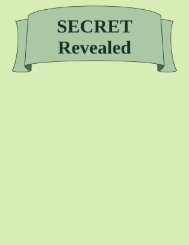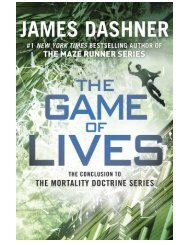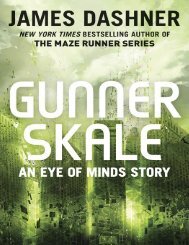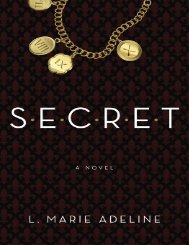32896589326509350
You also want an ePaper? Increase the reach of your titles
YUMPU automatically turns print PDFs into web optimized ePapers that Google loves.
of the body’s position and even its existence. Such immersion chambers could produce<br />
“altered states” much more profound than those described in the original experiments.<br />
At the time, such sensory deprivation tanks were sought out as avidly as (and sometimes<br />
combined with) “consciousness-expanding” drugs, which were more widely available<br />
then. 1<br />
There was a great deal of research on sensory deprivation in the 1950s and 1960s (a<br />
1969 book edited by Zubek entitled Sensory Deprivation: Fifteen Years of Research listed<br />
thirteen hundred references)—but then scientic interest, like popular interest, started<br />
to peter out, and there was relatively little research until the recent work of Alvaro<br />
Pascual-Leone and his colleagues (Merabet et al.), who designed a study to isolate the<br />
eects of pure visual deprivation. Their subjects, though blindfolded, were able to move<br />
around freely and “watch” TV, listen to music, walk outside, and talk to others. They<br />
experienced none of the somnolence, boredom, or restlessness the earlier test subjects<br />
had shown. They were alert and active during the daytime, when they carried tape<br />
recorders so they could take immediate note of any hallucinations. They enjoyed calm,<br />
restful sleep at night, and each morning they dictated what they could remember of their<br />
dreams—dreams that did not seem significantly altered by their being blindfolded.<br />
The blindfolds, which allowed the subjects to close or move their eyes, were worn<br />
continuously for ninety-six hours. Ten of the thirteen subjects experienced<br />
hallucinations, sometimes during the rst hours of blindfolding, but always by the<br />
second day, whether their eyes were open or not.<br />
Typically the hallucinations would appear suddenly and spontaneously, then<br />
disappear just as suddenly after seconds or minutes—although in one subject,<br />
hallucination became almost continuous by the third day. The subjects reported a range<br />
from simple hallucinations (ashing lights, phosphenes, geometrical patterns) to<br />
complex ones (gures, faces, hands, animals, buildings, and landscapes). In general, the<br />
hallucinations appeared full-fledged, without warning—they never seemed to be built up<br />
slowly, piecemeal, like voluntary imagery or recall. For the most part, the hallucinations<br />
aroused little emotion and were regarded as “amusing.” Two subjects had hallucinations<br />
which correlated with their own movements and actions: “I have the sensation that I can<br />
see my hands and my arms moving when I move them and leaving an illuminated trail,”<br />
said one subject. “I felt like I was seeing the pitcher while I was pouring the water,” said<br />
another.<br />
Several subjects spoke of the brilliance and colors of their hallucinations; one<br />
described “resplendent peacock feathers and buildings.” Another saw sunsets almost too<br />
bright to bear and luminous landscapes of extraordinary beauty, “much prettier, I think,<br />
than anything I have ever seen. I really wish I could paint.”<br />
Several mentioned spontaneous changes in their hallucinations; for one subject, a<br />
buttery became a sunset, which changed to an otter and, nally, a ower. None of the<br />
subjects had any voluntary control over their hallucinations, which seemed to have “a<br />
mind” or “a will” of their own.<br />
No hallucinations were experienced when subjects were engaged in challenging<br />
sensory activity of another mode, such as listening to television or music, talking, or

















